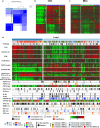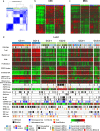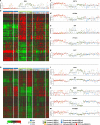Biological determinants of bladder cancer gene expression subtypes
- PMID: 26051783
- PMCID: PMC4650643
- DOI: 10.1038/srep10957
Biological determinants of bladder cancer gene expression subtypes
Abstract
Molecular stratification of tumors by gene expression profiling has been applied to a large number of human malignancies and holds great promise for personalized treatment. Comprehensive classification schemes for urothelial carcinoma have been proposed by three separate groups but have not previously been evaluated simultaneously in independent data. Here we map the interrelations between the proposed molecular subtypes onto the intrinsic structure of a rich independent dataset and show that subtype stratification within each scheme can be explained in terms of a set of common underlying biological processes. We highlight novel biological and genomic drivers of urothelial carcinoma molecular subtypes and show that tumors carrying genomic aberrations characteristic of distinct molecular pathways converge on a common top level phenotype corresponding to the two major molecular subtypes of non-muscle invasive disease.
Figures





References
-
- Epstein J. I., Amin M. B., Reuter V. R. & Mostofi F. K. The World Health Organization/International Society of Urological Pathology consensus classification of urothelial (transitional cell) neoplasms of the urinary bladder. Bladder Consensus Conference Committee. Am J Surg Pathol 22, 1435–48 (1998). - PubMed
-
- Fujimoto K. et al. Frequent association of p53 gene mutation in invasive bladder cancer. Cancer Res 52, 1393–8 (1992). - PubMed
-
- van Rhijn B. W. et al. The fibroblast growth factor receptor 3 (FGFR3) mutation is a strong indicator of superficial bladder cancer with low recurrence rate. Cancer Res 61, 1265–8 (2001). - PubMed
-
- Dalbagni G., Presti J., Reuter V., Fair W. R. & Cordon-Cardo C. Genetic alterations in bladder cancer. Lancet 342, 469–71 (1993). - PubMed
-
- Knowles M. A. et al. Allelotype of human bladder cancer. Cancer Res 54, 531–8 (1994). - PubMed
Publication types
MeSH terms
Substances
LinkOut - more resources
Full Text Sources
Other Literature Sources
Medical

